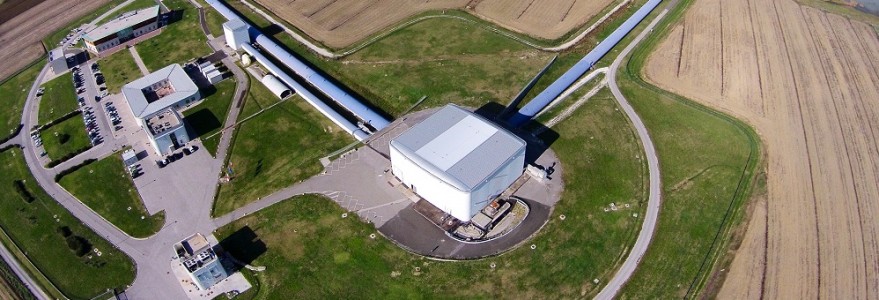The Virgo collaboration and the LIGO Scientific Collaboration report the three-detector observation of gravitational waves. This result highlights the scientific potential of a global network of gravitational wave detectors, by delivering a better localization of the source and access to polarizations of gravitational waves.
The two Laser Interferometer Gravitational-Wave Observatory detectors, located in Livingston, Louisiana, and Hanford, Washington, USA, and the Virgo detector, located at the European Gravitational Observatory in Cascina, near Pisa, Italy, detected a transient gravitational-wave signal produced by the coalescence of two stellar mass black holes.
The three-detector observation was made on August 14, 2017 at 10:30:43 UTC. The detected gravitational waves – ripples in space and time – were emitted during the final moments of the merger of two black holes with masses about 31 and 25 times the mass of the Sun and located about 1.8 billion light-years away. The newly produced spinning black hole has about 53 times the mass of our Sun. This means that about 3 solar masses were converted into gravitational-wave energy during the coalescence.
This is the fourth detection of a binary black hole system. While this new event is of astrophysical relevance, its detection comes with an additional asset: this is the first significant gravitational wave signal recorded by the Virgo detector, which has recently completed its upgrade to Advanced Virgo.
– It is wonderful to see a first gravitational-wave signal in our brand new Advanced Virgo detector only two weeks after it officially started taking data – says Jo van den Brand of Nikhef and VU University Amsterdam, spokesperson of the Virgo collaboration. – That’s a great reward after all the work done in the Advanced Virgo project to upgrade the instrument over the past six years.
The discovery, accepted for publication in the journal “Physical Review Letters” (https://dcc.ligo.org and http://www.virgo-gw.eu) was made by the Virgo collaboration and the LIGO Scientific Collaboration, which includes the GEO Collaboration and OzGrav.
The collaboration of LIGO and Virgo has matured over the last decade. Joint collaboration meetings and common data analyses have brought the community together. The coordinated scheduling of observing runs, with all detectors operational, is important to extract the maximum amount of science, and especially the vastly improved source localization holds great promise for the future of multimessenger astronomy. Additional results, based on data from the three-detector network, will be announced in the near future by the LIGO-Virgo collaboration; the analysis of the data is currently being finalized.
Overall, the Universe volume which is likely to contain the source shrinks by more than a factor 20 when moving from a two-detector network to a three-detector network. The sky region for GW170814 has a size of only 60 square degrees, more than 10 times better than for the two LIGO interferometers alone; in addition, the accuracy with which the source distance is measured benefits from the addition of Virgo. Being able to point to a smaller volume is important as many compact object mergers – for example when neutron stars are involved – are expected to produce broadband electromagnetic emission in addition to gravitational waves. The precision pointing information enabled 25 facilities to perform follow-up observations based on the LIGO-Virgo detection but no counterpart was identified – as expected for black holes.
Virgo doesn’t respond in the exactly same way to passing gravitational waves as the LIGO detectors because of its orientation on Earth, meaning that one can test another prediction of general relativity, which is concerned with polarizations of gravitational waves. Polarization describes how space-time is distorted in the three different spatial directions as a gravitational wave propagates. Initial tests based on the transient GW170814 event compare extreme cases: on the one hand, pure general relativity-allowed polarizations; on the other hand, pure polarizations forbidden by Einstein’s theory. The analysis of the data shows that Einstein’s prediction is strongly favored. In addition to this new result, other tests of general relativity already performed for the previous detections show an overall agreement between observations and general relativity.




